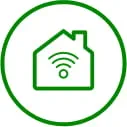Stuck with throttling internet? Here’s what might be going on.
Does your internet slow down at times, leading to buffering or frustratingly slow load times? This could be due to throttling, which is the intentional slowing down of internet speeds by internet service providers (ISPs) and mobile carriers.
Throttling can occur when people consume large amounts of data (like streaming a movie or using multiple devices at once), particularly during peak usage hours. ISPs tend to do this to control or limit the amount of data that some can consume over a specific period or to manage network congestion. Essentially, ISPs choke the flow of to more users or to prioritize certain customers.
Not all ISPs employ throttling, especially fiber internet companies. Ziply Fiber avoids the need to throttle due to their inherently fast speeds and large bandwidth capacities.
Why throttling occurs
An ISP may throttle an internet connection due to data limits, data prioritization or to mitigate large amounts of network traffic.
Data limits
The data you use monthly includes everything you upload and download, like movies, video games, video chats and web browsing. If your internet plan comes with a data cap, you can only use that much data before you see overage charges or a reduced connection speed caused by throttling. Many ISPs are moving away from data caps given the amount of content people currently consume. Still, even so-called unlimited plans can have hidden throttling policies.
Data prioritization
Some ISPs may reward certain websites or streaming services with faster load times. Often described as a “fast lane,” prioritization is like an entertainment service that allows you to go commercial-free if you pay. ISPs can make money off deep-pocketed companies willing to pay a premium. In some cases, ISPs might throttle specific types of internet traffic, such as video streaming or file-sharing services, to prioritize other types of traffic or to encourage users to subscribe to specific plans that offer better performance for those services. As a result, they “deprioritize” sites that don’t pay to play. This was all illegal until net neutrality was repealed in 2018.
Data prioritization/deprioritization can also occur when an ISP needs to cool things down. The company might frame this as a fair usage policy. That is, if you’ve reached your monthly data allowance, your ISP might start to prioritize other customers over you. This can happen even if you have an unlimited data plan. You won’t be charged for going over your data limit, but you may experience a slowdown, because your ISP wants you to share the road.
Network congestion
During peak usage times when many people are accessing the internet simultaneously, like evenings, the network can become congested. To ensure a more stable service for all users, the ISP may throttle the connection speeds of certain activities. This is common with legacy cable networks, which are working with limited bandwidth due to older technology and shared connections.
See What is network congestion and how do I fix it?
How fiber-optic internet avoids throttling
Fiber internet technology is built with state-of-the-art technology that can handle large data loads even at peak times. Here’s a breakdown of why fiber internet is better equipped to handle modern-day connectivity without needing to resort to throttling.
See What is fiber internet, and do I need it?
Speed
Fiber-optic cables use light signals to transmit data. Unlike traditional copper cables, which transmit data using electrical signals, fiber internet has an unmatched advantage: the speed of light. Data can simply travel much faster.
Symmetrical speeds
One of the most significant advantages of fiber internet is its symmetrical upload and download speeds. With traditional cable connections, the upload speed is usually much slower than the download speed. Fiber internet offers the same speed for both uploading and downloading, ensuring smoother video calls, faster cloud backups, and improved overall performance.
Less congestion
Traditional cable networks throttle data to manage the load. Congestion occurs more frequently on cable networks because of their limited bandwidth. Fiber networks, on the other hand, are typically built with more capacity to handle increased traffic without compromising speed or quality. This reduced susceptibility to congestion means fiber internet users are less likely to experience throttling.
See Understanding data caps and the benefits of unlimited internet
Dedicated connection
Fiber internet provides users with a dedicated connection, which means that the bandwidth you pay for is yours and is not shared with neighbors. Your internet experience remains consistent, regardless of the activities of others on the network.
Peering
One another technique ISPs like Ziply Fiber use is peering agreements, which enables ISPs to exchange traffic directly with each other and other content providers (like streaming services and social media platforms). This mutual agreement facilitates the exchange of data to help improve the efficiency and speed of data transfer, and therefore reduces the need for practices like throttling.
The importance of net neutrality
Some ISPs avoid practices like throttling because they believe in the importance of an open internet, even if it’s not mandated by law. Ziply Fiber, for instance, does not block content, throttle, cap data usage or prioritize paid content. At Ziply Fiber, we believe in net neutrality – that everyone should have access to the internet without any restrictions (with legal limits, of course). All ISPs are required to disclose their network management practices, so if you’re wondering whether your ISP is engaging in throttling or some other restrictive behavior, you should be able to find its policy on its website.
Fiber internet is future-proof
By now it should be clear that the problem of throttling is more common on traditional cable networks, which use legacy technology that has smaller bandwidth, shared connections, slower upload speeds and are less equipped for large files.
If your ISP is not throttling and your connection is still slow, you can look into some other culprits. If you’re using an old router, if you have a basic internet plan with low speeds, or if you’re using a device that’s too far from the router, you may experience lag, buffering wheels, frozen video chats and other annoying delays. These are problems that occur on your end, which you can fix by changing equipment or upgrading your plan. Throttling is a problem that occurs on the ISP’s end.
Fiber internet’s incredible speed, symmetrical performance, resistance to congestion, and dedicated connection all contribute to an internet experience that is virtually throttling-free. As our reliance on the internet grows, having a connection that is not only fast but also consistent becomes paramount. Fiber optic internet's ability to transcend throttling ensures that you can enjoy all your online activities, from streaming and gaming to remote work and virtual meetings, without the frustrating interruptions caused by slower speeds.






